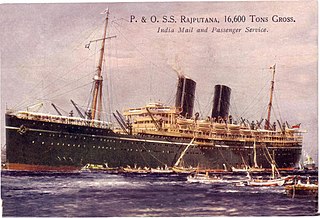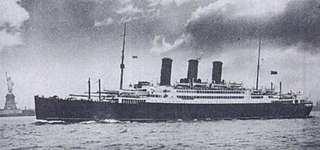
RMS Alcantara was an ocean liner which entered service just weeks before the start of World War I, was converted to an armed merchant cruiser in 1915, and was sunk in combat with the German armed merchant cruiser SMS Greif in the Action of 29 February 1916.

RMS Arlanza was a 14,622 GRT ocean liner of the Royal Mail Steam Packet Company. She was built in Belfast in 1912 for RMSP's scheduled route between England and South America. She was a Royal Navy armed merchant cruiser from 1915 until 1920. She returned to civilian liner service in 1920 and was scrapped in 1938.

HMS Rawalpindi was a British armed merchant cruiser that was sunk in a surface action against the German battleships Scharnhorst and Gneisenau during the first months of the Second World War. Her captain was Edward Kennedy.

SS Rajputana was a British passenger and cargo carrying ocean liner. She was built for the Peninsular & Oriental Steam Navigation Company at the Harland and Wolff shipyard at Greenock on the lower River Clyde, Scotland in 1925. She was one of the P&O R-class liners from 1925 that had much of their interiors designed by Lord Inchcape's daughter Elsie Mackay. Named after the Rajputana region of western India, she sailed on a regular route between England and British India.
Blücher was a wolfpack of German U-boats that operated during the World War II Battle of the Atlantic from 14 to 28 August 1942. They attacked the Freetown, Sierra Leone to Liverpool convoys SL-118 and SL-119, and sank six ships for a total of 41,984 gross register tons (GRT), and damaged one (10,552 GRT). The group was named after Gebhard Leberecht von Blücher (1742–1819), a Prussian Generalfeldmarschall in the Napoleonic Wars.

SS Ranchi was Peninsular and Oriental Steam Navigation Company "R"-class steam ocean liner that was built in 1925 and scrapped in 1953. From 1939 to 1943 she was the Royal Navy armed merchant cruiser HMS Ranchi.

California was a British 16,792 GRT steam turbine ocean liner built in Glasgow in 1923 for the Anchor Line. She was a sister ship of Cameronia, Tyrrhenia, Tuscania, Transylvania and Caledonia. In 1939 the Royal Navy requisitioned her. She was bombed and abandoned along with the Duchess of York west of Spain by a Luftwaffe attack in July 1943.
SS Dundee was a British steamship that was built in Scotland in 1911 and sunk by enemy action in the Celtic Sea in 1917. She was designed as a coastal passenger and cargo liner for the Dundee, Perth & London Shipping Company Ltd, but in 1915 she was converted into an armed boarding steamer for the Royal Navy. She took part in the Action of 16 March 1917, was sunk by a U-boat six months later, and lost members of her crew in both actions.

RMS Atrato was a UK steamship that was built in 1888 as a Royal Mail Ship and ocean liner for the Royal Mail Steam Packet Company. In 1912 she was sold and became the cruise ship The Viking. Late in 1914 she was requisitioned and converted into the armed merchant cruiser HMS Viknor. She sank in 1915 with all hands, a total of 295 Royal Navy officers and men.
SM U-66 was the lead ship of the Type U-66 submarines or U-boats for the Imperial German Navy during World War I. The submarine had been laid down in Kiel in November 1913 as U-7, the lead ship of the U-7 class for the Austro-Hungarian Navy. They became convinced after the outbreak of war in August 1914 that none of these submarines could be delivered to the Adriatic via Gibraltar, and sold the entire class, including U-7, to the German Imperial Navy in November 1914.

SS Corvus was a 1,317 GRT Norwegian steamship built in Copenhagen in 1920/21 by Kjøbenhavns Flydedok & Skibsværft A/S for the Norwegian passenger ship company Det Bergenske Dampskibsselskab of Bergen, which was attacked and sunk by two German U-boats in the Western Approaches of the English Channel on 27 February 1945.

SM U-21 was a U-boat built for the Imperial German Navy shortly before World War I. The third of four Type U-19-class submarines, these were the first U-boats in German service to be equipped with diesel engines. U-21 was built between 1911 and October 1913 at the Kaiserliche Werft in Danzig. She was armed with four torpedo tubes and a single deck gun; a second gun was added during her career.
Empire Breeze was a 7,457 GRT cargo ship which was built in 1940 for the Ministry of War Transport (MoWT). Shortly after entering service she ran aground but was repaired. Empire Breeze was torpedoed and sunk by U-176 on 25 August 1942.

The action of 29 February 1916 was a naval engagement fought during the First World War between the United Kingdom and the German Empire. SMS Greif, a German commerce raider, broke out into the North Sea and Admiral Sir John Jellicoe dispatched Royal Navy warships to intercept the raider. Four British vessels intercepted the commerce raider Greif. The armed merchant cruiser RMS Alcantara and Greif fought a brief engagement before British reinforcements arrived when both were severely damaged, both being sunk.
SS Vigrid was a Norwegian steam-powered cargo ship built in 1915. Sailing during the First World War, she was torpedoed and sunk without warning by a German U-boat on 31 December 1917.

Empire Endurance was a 8,514 GRT steam cargo liner that was built in 1928 as Alster by Deschimag Werk Vulkan, Hamburg, Germany for the shipping company Norddeutscher Lloyd. In the years leading up to the Second World War Alster carried cargo and passengers between Germany and Australia. After the outbreak of war she was requisitioned by the Kriegsmarine for use as a supply ship.

SS or RMS The Ramsey was a passenger steamer operated by the Isle of Man Steam Packet Company from 1912 to 1914. She had been built in 1895 as Duke of Lancaster for the joint service to Belfast of the London and North Western Railway and Lancashire and Yorkshire Railway companies. The steamer was requisitioned by the Admiralty in 1914 as the armed boarding vessel HMS Ramsey and sunk the following year.
Convoy HX 126 was the 126th of the numbered series of World War II HX convoys of merchant ships from HalifaX to Liverpool.

HMS Bayano, built in 1913, was originally a banana boat for the Elders & Fyffes line. At the outbreak of World War I it was drafted into the Royal Navy on 21 November 1914 as an armed merchant auxiliary cruiser. On 11 March 1915, it was torpedoed by SM U-27 and sank within minutes killing around 200 of its crew. Twenty-six survivors were pulled from the water.

HMS Mantua was a 20th-century ocean liner and armed merchant cruiser. Launched in 1909 as a passenger ship, Mantua was outfitted as an armed merchant cruiser in 1914 and served with the Royal Navy during World War I. On a voyage to Freetown in 1918, the passengers and crew of Mantua inadvertently spread the 1918 flu pandemic to Africa.
















